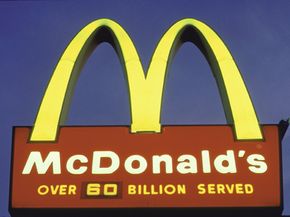Travel from California to Maine, and the accents and politics may change, but the Big Mac remains the same. As a fixture on the American landscape, and increasingly the world landscape, McDonald's restaurants are everywhere. Capitalizing on brand recognition, McDonald's is known for selling consistent, simple, low-priced American food. As a result, it has become the world's largest restaurant chain.
The figures are staggering: McDonald's stores number more than 30,000 and are located in more than 100 countries. They collectively serve 52 million people every day [source: McDonald's Corp.]. Consequently, McDonald's is also one of the most recognizable brands in the world. One marketing firm found that, in a survey of about 7,000 people in the U.K., Germany, Australia, India, and Japan, more people could identify the golden arches of the McDonald's logo than could identify the Christian cross [source: Schlosser].
Advertisement
However, during more than a half century that it's operated, McDonald's Corp. has been steeped in drama and scandal. Not only has it been at the center of high-profile lawsuits, but as the preeminent leader in the fast food industry, it's come to represent what some people consider dangerous about big corporations, fatty foods and the spread of American culture. Nevertheless, McDonald's has weathered every storm and responded with efforts to improve its image.
Besides its many critics, there are some who see in its success an example of the power of the American dream. Indeed, the story behind the rise of McDonald's is the stuff of legends. Since its humble beginnings, it has succeeded due to its dedication to streamlined service, but it was an ambitious visionary who took the idea of fast food and ran with it.
To understand the company that revolutionized the business of food, we'll have to go back to 1937, when two brothers by the surname of McDonald started a hot dog stand. Yeah, that's right: a hot dog stand.

